by Michael Frye | Dec 11, 2022 | Light and Weather, Vision and Creativity
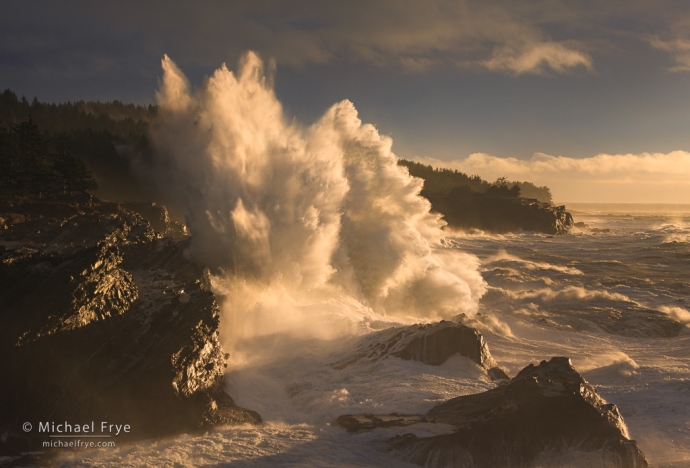
Crashing wave in late-afternoon light, Oregon coast. We had to deal with off-and-on rain while trying to photograph large waves crashing against the shore. But then the sun broke through for about five minutes late in the afternoon, bathing this scene in beautiful light. Luckily we caught a few big wave splashes during those five minutes. 70mm, 1/500 sec. at f/8, ISO 160.
After returning from New Zealand I made a trip to the Oregon Coast for our annual workshop. This part of the world is very different from my usual mountain haunts, which might be why I enjoy it so much. There’s a wild, rugged grandeur to this coastline, and if you’re lucky enough to encounter some big waves that just adds to the sense of awe.
And we did experience some big waves. Watching – and hearing – those monsters crash ashore was an experience none of us will soon forget. But even under calmer conditions this area offers wonderful opportunities to capture moody scenes of fog, or stormy skies.
(more…)
by Michael Frye | Nov 20, 2022 | Light and Weather, Vision and Creativity
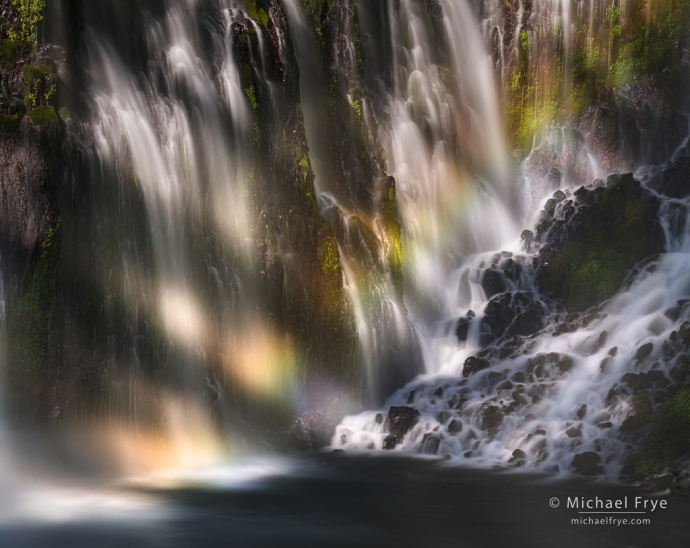
Tree shadows, rainbow, and waterfall, California. Claudia and I photographed this waterfall in soft light the evening before, but I came back the next morning hoping to see tree shadows when the sun got high enough. And sure enough, eventually trees cast beautiful striped shadows across the fall, creating a sunbeam-like effect. But I didn’t expect to also see a rainbow interspersed with the tree shadows – a nice bonus. I used a telephoto lens to fill the frame with the most eye-catching part of the scene, a polarizer to enhance the rainbow, and a neutral-density filter to slow down the shutter speed and give the water a soft, silky appearance. 135mm, 3 seconds at f/16, ISO 100, polarizer, ND filter (probably a 7-stop filter).
I love waterfalls. Who doesn’t? Besides their beauty, large waterfalls cast negative ions into the air, and negative ions supposedly have health benefits – making people feel refreshed and renewed, helping regulate sleep patterns and mood, reducing stress, and boosting the immune system. Or not; the scientific evidence is mixed at best. But whatever the reason, people seem magnetically drawn to waterfalls.
And of course waterfalls are quite photogenic. Over the past year I’ve had the opportunity to visit several waterfalls I’ve never photographed before. And while soft light usually works for waterfalls, I tried to seek out more unusual lighting conditions that could give the photographs a different look and feeling. That meant using sunlight, but waterfalls usually reside in basins and canyons, so they don’t often get that warm, low-angle light that we’re often looking for. And when the sun does get high enough to strike the fall, it’s often filtered through trees, creating splotchy light. Splotchy light can be harsh and downright awful, but sometimes, under the right circumstances, it can work. And – again, under the right circumstances – backlight can highlight a waterfall’s spray. And while front light is usually flat and boring, with waterfalls it can create rainbows.
(more…)
by Michael Frye | Sep 22, 2022 | Light and Weather, Vision and Creativity
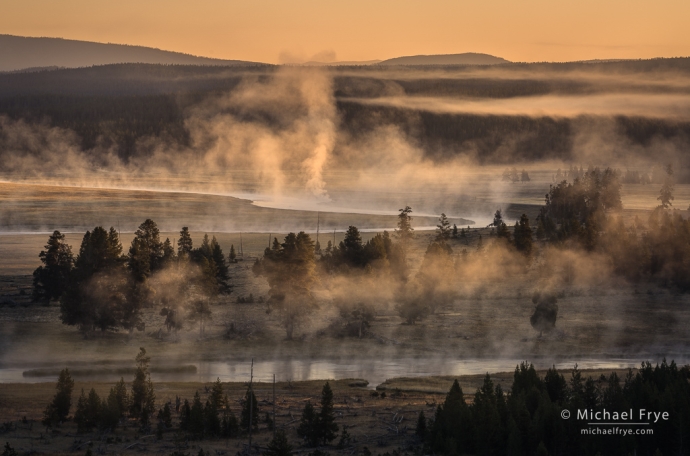
Layers of fog, Yellowstone NP, Wyoming. Early one morning I climbed a low hill, trying to gain some elevation so I could look down on the fog. After sunrise I noticed beautiful sidelight raking across this scene of a meandering river, so I raced along the hilltop to get a better view and composed this image. I like the horizontal layers of light and dark, punctuated by the vertical, curving column of steam that added a necessary visual focal point. 160mm, 1/20 sec. at f/16, ISO 100.
As I said in my last post, I love photographing fog and mist, so here are more misty images from our trip to Yellowstone. I explain my approach to photographing these scenes in that previous post, but the captions here contain more detail about the specific photos shown.
— Michael Frye
(more…)
by Michael Frye | Sep 20, 2022 | Light and Weather, Vision and Creativity
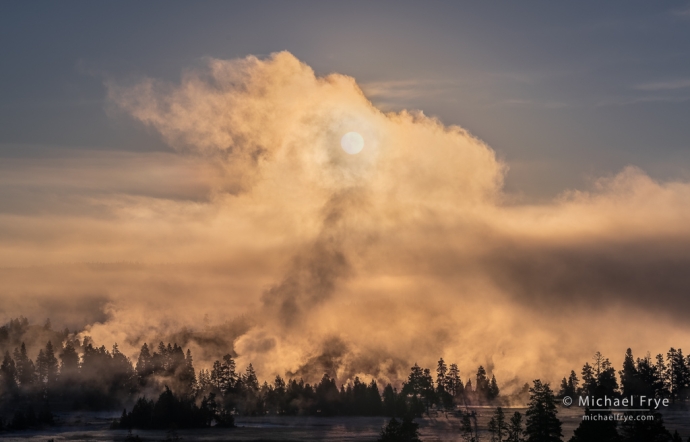
Sun rising through fog and steam, Yellowstone NP, Wyoming. Standing on a low hill, I moved to position the sun behind the column of steam, in order to avoid lens flare and prevent the sun itself from being completely blown out. With this extreme constrast I bracketed five frames, two stops apart, and blended the exposures with Lightroom’s HDR Merge. 100mm, bracketed shutter speeds, f/11, ISO 100.
If you read this blog regularly you know that I love fog and mist. And few places generate fog and mist as consistently as the thermal areas of Yellowstone during cold weather. Warm, moist air rising from the geysers and hot springs into the colder surrounding atmosphere creates a perfect recipe for mist formation.
During the first part of our stay in Yellowstone the daytime highs were in the low to mid 80s. But the daily temperature fluctuations were tremendous, so the next morning the thermal areas would be near freezing – a difference of around 50 degrees Fahrenheit (or about 28 degrees Celsius). So despite unusually warm days for early September, we still found plenty of steam and fog in the mornings. And toward the end of our stay a cold front came through, temps dropped, and we saw even more mist.
(more…)
by Michael Frye | May 11, 2022 | Travels and Stories, Vision and Creativity
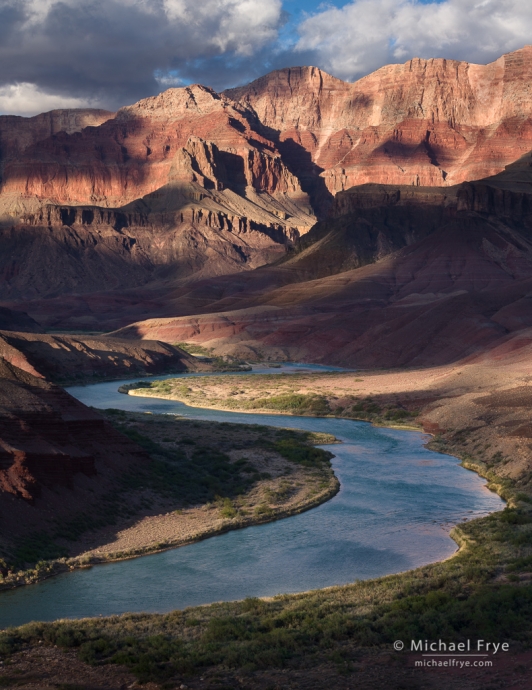
Dappled light along the Colorado River, Grand Canyon National Park. Watching the cloud shadows move across the canyon from this spot was one of the highlights of the trip for me.
Most people make their best photographs of places or subjects they’re familiar with.
In landscape photography, it helps immensely if you know an area well, and know what spots might work best under certain conditions, so you can put yourself in the right place at the right time.
I think it’s also natural and inevitable that we’re going to make our best and most meaningful images when we feel a connection with the subject or place. You can often trace a direct correlation between the depth of that connection and the depth of the imagery. And making those connections takes time.
(more…)
by Michael Frye | Feb 17, 2022 | Advanced Techniques, Vision and Creativity
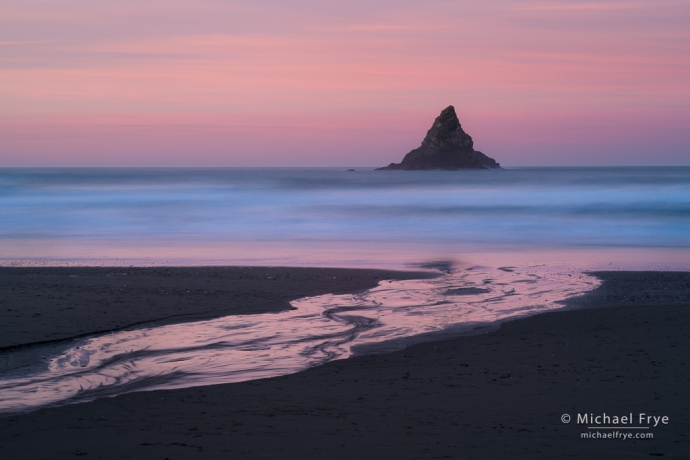
Creek and sea stack, sunrise, Oregon Coast. I used a slow shutter speed (30 seconds) to smooth the waves, which simplified the scene by eliminating texture in the water, and helped create a more ethereal quality to the image.
In one of my posts about Yellowstone last fall I talked about my attraction to dynamic landscapes. And Yellowstone is certainly dynamic, with its ever-changing array of spouting geysers and steaming vents.
But seascapes might be even more dynamic. In addition to the usual variables of landscape photography – light and weather – there’s the ocean itself. Tides, wave height, wave direction, and wind all have big effects on the way a scene looks. And no two waves are the same, so one moment will often look quite different from the next.
(more…)














